Summary
A method is described for the isolation of large numbers of viable disaggregated cells from human tissues. This method combined the mechanical action of a Stomacher Model 80 Lab Blender, 0.1 mg/ml trypsin or 0.5 mg/ml collagenase, and 0.1 mM [ethylene bis(oxyethylenenitrolo)]-tetraacetic acid (EGTA). Tissue (0.2 to 1.0 g) obtained from human fetal intestine, kidney, liver, lung, and skin were separately minced into approximately 1-mm3 pieces. The pieces were placed in a sterile bag containing 60 ml of calcium- magnesium-free phosphate buffered saline, the appropriate enzyme (0.1 mg/ml trypsin or 0.5 mg/ml collagenase) plus 0.1 mM EGTA, and 0.1% methylcellulose. The bag was then placed into the blender and mixed at a low speed for 3 to 20 min at room temperature. After a single cell suspension was observed by phase contrast microscopy, 10 ml of bovine calf serum was added to the cell suspension to inactivate the proteolytic enzymes. At this time 130 ml of cold Hanks' balanced salts solution containing 5% bovine calf serum was added and the entire cell suspension passed through a tissue sieve (100 mesh, 140 μm) and the cells collected by centrifugation. These cells were then resuspended into the appropriate culture medium. In comparison to other methods for establishment of cell cultures from human tissues, the method described requires shorter incubation times with relatively low concentrations of proteolytic enzymes, and yields two- to three-fold greater number of cells per tissue with 86 to 93% viability. Also, depending on the cell type, 50 to 75% of the isolated cells attached to the culture vessel within 24 h. Variation of the time and concentration of digestive enzymes can be used to select different cell types for culture.
Similar content being viewed by others
References
Bashor, M. M. Dispersion and disruption of tissues. Methods Enzymol. 28: 119–140; 1979.
Gibson-D'Ambrosio, R. E.; Leong, Y.; D'Ambrosio, S. M. Human fetal kidney cells in culture exhibit reduced levels of DNA repair compared to human fetal dermal fibroblasts. In Vitro 17: 299–300; 1982.
Gibson-D'Ambrosio, R. E.; Leong, Y.; D'Ambrosio, S. M. DNA-repair following ultraviolet andN-ethyl-N-nitrosourea treatment of cells cultured from human fetal brain, intestine, kidney, liver, and skin. Cancer Res. 43: 5846–5850; 1983.
Hanks, J. H.; Wallace, R. E. Relation of oxygen and temperature in the preservation of tissues by refrigeration. Proc. Soc. Exp. Biol. Med. 71: 196–200; 1949.
Harris, C. C.; Trump, B. F.; Stoner, G. D., eds. Methods in cell biology. Normal human tissue and cell culture: A. Vol. 21 1980.
Harris, C. C.; Trump, B. F.; Stoner, G. D., eds. Methods in cell biology. Normal human tissue and cell culture: B. Vol. 21 1980.
Montes de Oca, H. Primary tissue dissociation. Trypsin. B. High yield method for kidney tissue. In: Kruse, P. F.; Patterson, M. K., Jr., eds. Tissue culture: methods and application. New York: Academic Press; 1973: 8–12.
Paul, J. Cell and tissue culture, Fourth Ed. Baltimore: Williams and Wilkins Comp.; 1970: 203–213.
Pretlow, T. G., II Pretlow, T. P. Derivation of cells in culture. In Vitro Monogr. 5: 4–19; 1984.
Raber, J. M.; D'Ambrosio, S. M. Isolation of single cell suspensions from the rat mammary gland: Separation, characterization, and primary culture of various cell populations. In Vitro (in press).
Robb, J. A. Single cell isolation and cloning. In: Kruse, P. F.; Patterson, M. K., Jr., eds. Tissue culture methods and application. New York: Academic Press; 1973; 270–274.
Seglen, P. O. Preparation of rat liver cells. II. Effect of ions and chelators on tissue dispersion. Exp. Cell Res. 76: 25–30; 1973.
Kruse, P. F., Jr., Patterson, M. K., Jr., eds. Tissue culture: methods and application. New York: Academic Press: 1973.
Waymouth, C. To disaggregate or not to disaggregate. Injury and cell disaggregation, transient or permanent? In Vitro 10: 97–111; 1974.
Waymouth, C. Methods for obtaining cells in suspension from animal tissues. In: Pretlow, T. G., II; Pretlow, T. P., eds. Cell separation: methods and selected applications. 1982: 1–30.
Author information
Authors and Affiliations
Additional information
This work was supported by research grants from the National Institute of Environmental Health Sciences, Bethesda, MD (ES3101) and the United States Environmental Protection Agency, Washington, D. C. (R810146).
Rights and permissions
About this article
Cite this article
Gibson-D'ambrosio, R.E., Samuel, M. & D'Ambrosio, S.M. A method for isolating large numbers of viable disaggregated cells from various human tissues for cell culture establishment. In Vitro Cell Dev Biol 22, 529–534 (1986). https://doi.org/10.1007/BF02621139
Received:
Accepted:
Issue Date:
DOI: https://doi.org/10.1007/BF02621139




